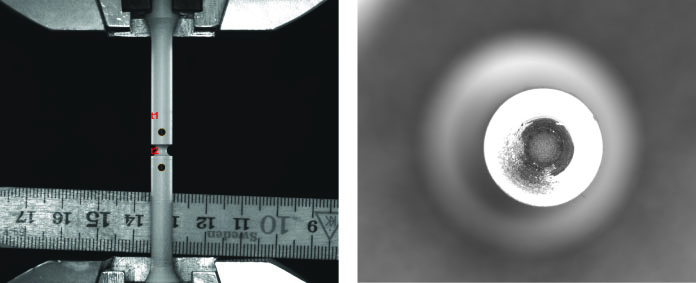
The research topics in the field of fatigue of metal structures include a variety of topics as summarized below:
– The fatigue behavior of tubular cast nodes or welded joints in bridges (effects of residual stresses; application of high-strength steel)
– The remaining fatigue life of existing bridges
– The behavior of welded joints under seismic loading (low-cycle fatigue)
– Modeling of traffic loads on existing road bridges (fatigue loading)
Current research projects
Fatigue behavior of tubular K-joints in high-strength steel
The use of circular hollow section (CHS) profiles in construction of road truss bridges has been growing during the past 20 years, mainly in Europe. Aesthetics, structural efficiency, and sustainability are three factors that make these structures advantageous compared to other structures, specially for mid-sized span bridges. Use of newly developed high strength steel profiles instead of traditional steel grades can make these structures more attractive for architects and designers since it yields lighter structures.
Nevertheless, the use of high strength steels can not be promoted unless potential fatigue issues are properly addressed. Previous research indicates that the problematic fatigue cracking sites are located within the truss joints, for which two fabrication solutions are currently available: welding the tubes together, or using cast steel nodes and connecting truss members to them by girth welds. Fatigue performance of these two solutions will be investigated during this research project using experiments and numerical simulations. Experiments consist of full-scale fatigue tests plus measurement of residual stresses in the weldments. Recent research in ICOM (Acevedo, 2011) has highlighted the governing role of residual stresses in fatigue crack propagation at the welded detail. For the numerical study part, thermo-mechanical simulation of welding process will be used to evaluate the residual stress field at the weld region. This will be followed by crack development analysis to assess the fatigue lives of the details. Presence of the residual stresses affects the fatigue crack path, which leads to change in the fatigue life of the detail. Parametric studies will be done to understand how the residual stresses and fatigue life of the details change with the change of geometric parameters. The aim is to assess the fatigue lives of the two types of joints and to evaluate change in the fatigue strength in relation to change in the geometric parameters of the connection.
Transitional FAbricated STeel (FAST) Structures for Developing Regions; ‘FAST HOMES’
This research is an international collaborative project with currently IIT Kampur and Gandhinagar India, Universidad del Estado de Río de Janeiro, Brazil, Stellenbosch University, South Africa, Central University of Las Villas, Cuba.
The aim of the FAST Homes research is to develop cheap, sustainable, and economy-stimulating housing for developing regions impacted by natural disasters. Natural disasters in developing regions often destroy homes and force people into temporary shelters such as tents or ‘shanties’. These tent structures and shanties are intended to provide temporary shelter immediately following the disaster; however, due to prolonged rebuilding times they often function as semi-permanent housing, disrupting normal livelihood. Current prefabricated housing methods (tents, sandwich-panel construction, etc.) use elements that are created abroad, imported to the country in need, and then assembled often by teams of skilled foreign laborers. Foreign products and foreign labor, while stimulating to the foreign economies, do little to stimulate local economies. Methods that use locally fabricated elements and can be assembled with local unskilled labor are desired.
In this study, a promising steel log cabin (SLC) design is investigated. The SLC design uses thin steel tubes stacked horizontally (similar to typical log cabin construction) and connected with interlocking joints. With the SLC design structural elements (thin galvanized steel tubes) are easily fabricated and assembled on-site using only imported steel coils and a forming machine (the same machine used to fabricate ventilation ducts). The thin steel tubes create the supporting structure, façade, and may allow for both ventilation and insulation.
This research investigates multiple aspects of the SLC design, including both cultural and structural aspects. Cultural surveys are carried out in developing regions to assess local perceptions of living in a steel house, the willingness of locals to fabricate their own homes; and various other issues related to local construction.
Additionally, structural testing is carried out to determine the lateral resistance of the unique steel log cabin (SLC) design. This testing will aid in the development of simple solutions for earthquake or hurricane prone regions.
Ultra Low Cycle Fatigue of welded joints under variable multi-axial strains
The phenomenon of ultra-low cycle fatigue (ULCF) and damage of welded joints under multi-axial and variable amplitude strains is complex and not completely understood. This phenomenon has particular significance for safety and environmentally relevant structures (above-ground petroleum tanks, masts for wind turbines, pressure vessels and tubular bridge piers) subjected to extreme loading such as seismic or wind gust loads. In the case of above ground tanks, severe seismic loading conditions can cause the tank bottom to uplift. This behavior causes extensive plastic deformation in the region near the welded connection between the tank wall and the bottom plate, which occur with highly variable and stochastically distributed amplitudes. ULCF fracture has also been observed in tubular elements such as bridge piers, pipelines, and mast shafts, causing human and economic losses. Very little information exists concerning the ULCF response of welded connections subjected to multiaxial loading. Confirmed knowledge and new engineering design procedures would allow for an increase in safety under load scenarios causing extraordinary local cyclic strains in short times.